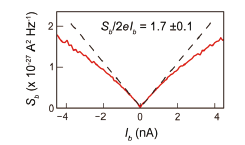Shot Noise Measurement of Local Fermi Liquid Out of Equilibrium
R. Sakano, M. Ferrier, and K. Kobayashi
Nine years after Millikan’s monumental work on first observation of the elementary charge of the electron e in the famous oil drop experiment in 1909, Schottky also proposed an idea of measuring electric charge from the electron flow generated between two electrodes in a vacuum tube, by using statistical properties of electron counting and its fluctuation. For electric current generated by rare events (Poissonian process), the average current (I) is proportional to its fluctuations, namely, the shot noise (S), through the relation S = 2e*I where e* is the effective charge of the current carrying state.

Fig. 1. The red solid line is the measured shot noise Sb as a function of the backscattering current Ib at 16 mK. The black broken line is Sb = 2(1.7)eIb .
Particularly, in condensed matter physics, many-body effect in conductor can generate nontrivial effective charges of their quasiparticle state, which has been studied in nano-sized electronic devices. For instance, fractional charges of Laughlin’s quasiparticle in fractional quantum Hall systems, and double charge of cooper-pair in normal metal-superconductor junction were already detected in noise experiments.
By means of ultrasensitive current-noise measurement techniques, we recently succeeded in observing the shot noise and formation of effective charge states due to the spin Kondo effect in a carbon-nanotube quantum-dot, which is another typical many-body effect [1]. Applying small bias voltages between two electrodes connected to the quantum dot containing a single electron, enhancement of current noise due to emergence of the Kondo effect in the quantum dot at low temperatures, is observed.
The averaged current and current noise in the Kondo dot can be described by the local Fermi liquid which is an extension of the Landau’s Fermi liquid to impurities or quantum dots and the ground state of the Kondo effect. Tuning the dot level and the lead-dot mixings to hold the particle-hole symmetry, the bias-voltage linear response current shows perfect transmitting current due to the formation of quasiparticle’s resonant level at the Fermi level, and this current does not fluctuate since no scattering occurs. Then, the leading nonlinear current is third order in bias voltages due to very small backscattering current (Ib). Thus, the current fluctuation from this nonlinear current (Sb) is found to follow the statistics of the Poissonian process. Theoretically, the noise emerges from three type of scattering processes described by the local Fermi liquid. First is the free quasiparticle’s backscattering by the linewidth of the resonant level, with effective charge e. Second and third are backscattering of single quasiparticle and quasiparticle’s pair by the residual interaction with effective charge e and ‘2e,’ respectively. In particular, the quasiparticle’s pair scattering enhances the shot noise and effective charge of the non-equilibrium current through the Kondo quantum dot. The difference from fractional Hall states or superconducting states is that the Fermi liquid state has no energy gap at low energies. Thus mixture of the three scattering states with different effective charges composes the non-equilibrium current through the Kondo dot. As a consequence of two different effective charges in current, it is theoretically predicted that the noise-average ratio for the backscattering current takes the value ![]() in the Kondo limit [2-4]. The figure shows the observed shot noise as a function of the averaged backscattering current at 16 mK. For small currents noise-current ratio takes the values of
in the Kondo limit [2-4]. The figure shows the observed shot noise as a function of the averaged backscattering current at 16 mK. For small currents noise-current ratio takes the values of ![]() = 1.70 ± 0.1, which is in very good agreement with the theoretical prediction. As mentioned above, this result corresponds to direct detection of quasiparticle pair creation in excited states of the local Fermi liquid. Furthermore, we investigate bias-voltage linear noises in the dot with particle-hole asymmetry and Fermi liquid parameters appearing in the averaged current, to ensure the accuracy of our shot noise measurement.
= 1.70 ± 0.1, which is in very good agreement with the theoretical prediction. As mentioned above, this result corresponds to direct detection of quasiparticle pair creation in excited states of the local Fermi liquid. Furthermore, we investigate bias-voltage linear noises in the dot with particle-hole asymmetry and Fermi liquid parameters appearing in the averaged current, to ensure the accuracy of our shot noise measurement.
To conclude, our work offers a new approach to analyze excited states of electron correlated states though shot noise measurement in out of equilibrium systems.
References
- [1] M. Ferrier T. Arakawa, T. Hata, R. Fujiwara, R. Delagrange, R. Weil, R. Deblock, A. Oguri, and K. Kobayashi, Nat. Phys. 12, 230 (2016).
- [2] E. Sela Y. Oreg, F. von Oppen, and J. Koch, Phys. Rev. Lett. 97, 086601 (2006).
- [3] A. O. Gogolin and A. Komnik, Phys. Rev. Lett. 97, 016602 (2006).
- [4] R. Sakano, T. Fujii, and A. Oguri, Phys. Rev. B 83, 075440 (2011).
